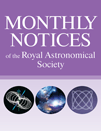Constraining the topology of the Universe using the polarized cosmic microwave background maps
ABSTRACT
We study the possibility for constraining the topology of the Universe by means of the matched circles statistic applied to polarized cosmic microwave background (CMB) anisotropy maps. The advantages of using the CMB polarization maps in studies of the topology over simply analysing the temperature data as has been done to date are clearly demonstrated. We test our algorithm to search for pairs of matched circles on simulated CMB maps for a universe with the topology of a 3-torus. It is found that the noise levels of both Planck and next generation CMB experiment data are no longer prohibitive and should be low enough to enable the use of the polarization maps for such studies. For such experiments, the minimum radius of the back-to-back matched circles which can be detected is determined. We also show that the polarization generated after reionization does not have an impact on the detectability of the matched circles.




